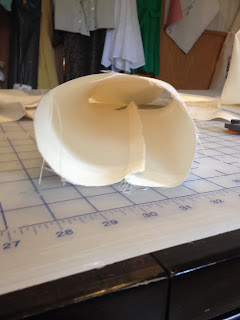Construction
The waistcoat was made first, being small and
attainable. While I love the finished
look of a shawl collar, I decided to go with a laid-on collar because it
reduced bulk in the back and allowed for a nice inner curve to the lapels,
which I coveted. The construction for
this was fairly simple, and when he wore it out into the afternoon sunlight the
big cut-glass beads along the lapels shot shafts of colored light.
 |
| Waistcoat lapels at edges, beaded before cutting. |
I tailored the coat next, padstitching it to hair canvas,The Victorian Tailor by Jason Mclachlann. Go there if you want to feel small and
insignificant under the weight of the lifetime of mastery it takes to really be
a tailor. For example, the essential art
of shaping the suit with an iron “is not included in the scope of this book”,
but most other things are.
a
technique I learned through the glorious Gertie’s Blog for Better Sewing. If you want to know how to tailor, go
there. I also had lotsa help from
I sewed the back and shoulder seams by hand, because I did
not have a zipper foot that could get close enough to the beadwork for a smooth
seam. The tendrils curling onto the
front don’t meet at the shoulder seams, and that was unfortunate, but better
luck next time! It’s not like it was
easy!
The jacket was fully bag-lined with two inside welt pockets
and lots glass buttons. I made keyhole
buttonholes on my friend’s Janome.
 |
| I practiced my padstitching on the Suit's predecessor |
 |
| Look at the hand on that gab! |
 |
| Apparently I only took pictures of the sleeves while constructing. |
 |
| On the right you can see the back panels painstakingly handstitched together. |
The trousers were probably the most complicated! I started with the laughing moon California
pants pattern, and changed it to reflect the grown-on waistband that gets all
cool and high in the back. It was to be
held up with suspenders for a smooth line over the abdomen. I followed the trousers instructions in The
Victorian Tailor for making up. After cutting
the facings, interfacing, suspender button stays, pocket stays, waist stays,
hip stays, curtains, pockets, etc. I
must have had 30 pieces all told of three different fabrics. I did a lot of hand basting, and finished the
pockets as per the recommendations. I
had cut them slightly too short so I added a shaped facing for the hem rather
than turning it up. The nine button fly
features nine hand sewn buttonholes because the trousers were constructed over
a brutal heatwave leaving my sewing room too hot to work in and me naked in the
living room trying not to sweat on the gabardine.
We completed the outfit with silk trouser socks from REI, an
antique brooch in the figure of Hanuman, a vintage Italian tuxedo shirt with a
pique front, vintage studs and cuff links that I had bought him years ago, and
the most gorgeous shoes I have ever seen.
They were ordered from Pakistan, and embroidered with gold thread and
tiny metal coils, which is apparently what bullion is! It was like if Aladdin was Cinderella. We kept them secret until the very day.
 |
| Shoes and wedding china! |
All together now!













































